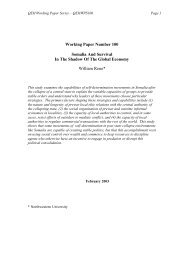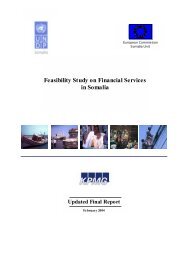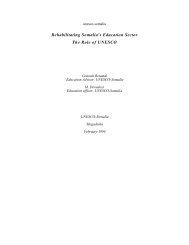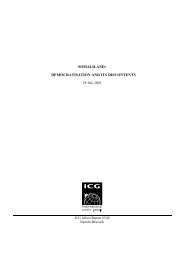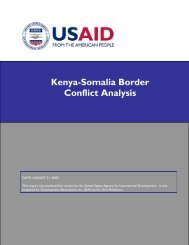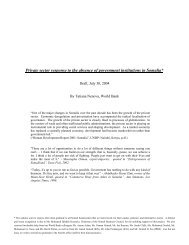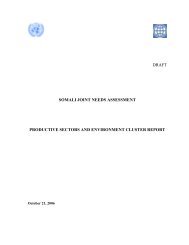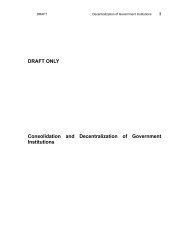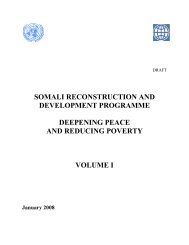Primary Education Survey Evaluation Report Somalia - Somali - JNA
Primary Education Survey Evaluation Report Somalia - Somali - JNA
Primary Education Survey Evaluation Report Somalia - Somali - JNA
Create successful ePaper yourself
Turn your PDF publications into a flip-book with our unique Google optimized e-Paper software.
PES <strong>Evaluation</strong> <strong>Report</strong>, 2008<br />
Study Components<br />
The principal source of data will be interviews with respective stakeholders. Respondents<br />
will include MoE officials at central, regional and district levels, NGO officials, head<br />
teachers, teachers, survey enumerators, supervisors, UNICEF/UNESCO staff at Nairobi<br />
and zonal level as well as local and international NGOs. The methods followed would be<br />
largely qualitative and include key informant semi-structured interviews, community level<br />
interviews and focus group discussions. Questionnaires for guiding the interviews will be<br />
developed for review in the inception phase. (PES <strong>Evaluation</strong> TOR 2008)<br />
The task of this methodology section is to coordinate these process components with the 7 areas identified<br />
above. The 7 areas are further clarified and designed in Appendix 4 by the use of 40 research questions<br />
mapped onto the 7 areas. A research matrix was developed that linked relevant data sources<br />
(stakeholders) with the research questions. This appendix is referred to as the Data Collection Planner.<br />
This matrix was used to ensure that each research question had an associated data source to inform it, to<br />
identify people who would reasonably be expected to have relevant knowledge and experience to inform<br />
each research question, and to guide the development of the interview guides that would assist the<br />
researcher in generating the conversation in the semi structured interview environments. These processes<br />
were validated by consultation with a range of stakeholders who have personal and detailed knowledge of<br />
the context of the research.<br />
The Data Collection planner was used to develop seven Interview guides. These guides targeted UNICEF<br />
officers, Directors General of <strong>Education</strong>, planning officers in each Ministry, Regional and District<br />
<strong>Education</strong> Officers, School and community leaders, <strong>Survey</strong> team members, and NGOs/international<br />
organisations. In addition, questions that could be informed by the desk review were identified.<br />
Appendix 5 indicates the set of interviews and focus groups conducted in the data collection process.<br />
The semi-structured interviews with individuals and focus groups were recorded and salient information<br />
mapped onto research questions. These data were synthesized and interpreted by the consultant prior to<br />
drawing conclusions and making recommendations.<br />
To enhance the validity of the study a number of strategies were used that were drawn from the<br />
qualitative research literature (LeCompte and Preissle, 1993). These involve enhancing the<br />
“trustworthiness” of the research. The strategies included triangulation, building a comfortable non<br />
threatening relationship with interviewees, creating an audit trail of data using a digital recorder in<br />
interviews, seeking permission of interviewee to record the interview with an offer to turn the recorder off<br />
if requested, seeking specific examples in support of claims being made, asking to see documentary<br />
evidence of claims and comments, and providing a summary of conversations by listing major points and<br />
seeking concurrence from interviewees.<br />
A few further words on triangulation are warranted. This is a process where the researcher tries to get<br />
multiple sources of evidence to assist in making conclusions in relation to the study. To this end, after<br />
studying the Data Collection Planner (Appendix 4) it can be seen that each research question is to be<br />
investigated with several stakeholders. Additionally, when claims are made attempts will be made to<br />
triangulate the claim with documentary, or physical evidence. In general, matters of fact should be agreed<br />
upon by all data sources. Some variability will be expected in views, or attitudes of a more subjective<br />
nature. Often it can be expected that this variability is a function of varying positions in the system. For<br />
example the Director General might see data as a valuable help to decision making and resource<br />
allocation, whereas teachers might see the collection of the same data as an imposition that reduces the<br />
time they have for lesson preparation.<br />
There were a number of threats and limitations to the study that should be enumerated. During the period<br />
of the study (July/August) schools were closed for the summer break and hence were not available for<br />
observation in a natural setting. Attempts were made to contact some local principals and school<br />
representatives for interview.<br />
12



